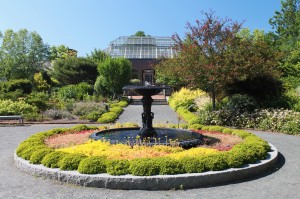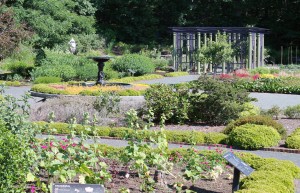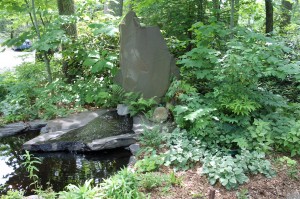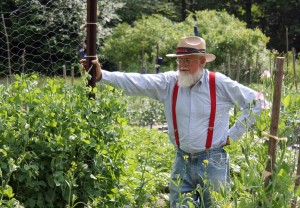Yankee (and Red Suspenders) Garden Wisdom
July 8th, 2014
There’s no better place to learn about plants than public gardens… except if you go to the home garden of someone who really knows what he’s talking about.

A fountain surrounded by creeping sedums makes a beautiful focal point at Tower Hill Botanical Garden.
I’m just back from taking a busload of Harrisburg-area gardeners to see both – a selection of great public gardens of New England and the home garden of long-time Victory Garden TV host Roger Swain, he of red-suspenders fame.
One of the public-garden stops was the Coastal Maine Botanical Gardens in Boothbay, Maine. That one immediately jumped onto my list of top 10 all-time gardens and is so impressive that I have to devote an entire post to it. See a Photo Gallery of pictures from CMBG to judge for yourself.
Two other public gardens we saw are well worth singling out this week as well as adding to your must-visit list if you ever get up to the Boston area.
Tower Hill Botanical Garden Tower Hill Botanical Garden is a young public garden, opened in 1986 by the Worcester, Mass., County Historical Society. Its 132 acres are still being planted. What grabbed me most there was the “Systematic Garden.” Rather than lay out plants in beds by their use or by how they pair with one another, this one groups plants by their botanical families and when those families came along in the evolution of plants.
Did you know that cherry trees, hawthorns and cotoneasters are members of the same 2,800-species rose family? Or that ferns are some of the planet’s oldest plants? Want to guess the most highly evolved family at the opposite end of the fern spectrum? Asters.
Tower Hill has a nice mix of formal and natural areas, including a large event lawn surrounded by 1,000 trees and shrubs, a mid-1700s New England woodland with trails, and a beautiful cottage garden of perennials and flowering shrubs. It’s also got an ornamentally planted vegetable garden and a collection of more than 200 heirloom apple varieties.
The gardens are still working through their first 50-year master plan, which was designed by Pittsburgh-based Environmental Planning and Design, the same firm that designed Pittsburgh’s waterfronts and the plaza around the Capitol fountain in Harrisburg. Garden in the Woods The second Boston-area garden worth a look is the Garden in the Woods near Framingham, Mass. This one reminds me of Bowman’s Hill Wildflower Preserve in Bucks County, Pa. Both places are devoted to native plants and display hundreds of regionally native trees, shrubs, perennials and grasses in rolling, mostly wooded settings.
The New England Wildflower Society, which formed to discourage florists from raiding the woods for plants, operates this 45-acre garden started by landscape architect and conservationist Will Curtis in 1931.
The valuable duty of Garden in the Woods is showing how many alternatives home gardeners have for the shade other than just hostas and pachysandra. It also shows what these alternatives look like in a real garden setting.
The garden has 1,000 different native species and counting, making it the largest collection of native plants in New England. Most of the plants there do well in Pennsylvania gardens and happen to be native to our region, too.
Roger Swain’s Garden The best way I can describe Roger is that he’s the fastest way to learn a whole lot about gardening. You’ll pick up more useful advice from him in 2 hours than in 2 years of reading or 22 years of watching HGTV. Our visit was a reminder what a loss it is for gardening TV and gardeners in general not to have him giving us all tips every weekend from the Victory Garden plots.
Roger’s mostly retired now… if you call maintaining an acre’s worth of orchard and two large vegetable gardens “retired.”
Just like on his 500-plus episodes of The Victory Garden, Roger mixed witticisms and plant lore with down-and-dirty tips:
“A perennial is a plant that had it lived, would have bloomed every year.”
“’Oregon Giant’ is by far the best snow pea.
‘Hakurei’ is the best turnip.’”
“You know how to tell when a water lily is done blooming? Give the bud a little goose, and if it squirts, it’s done.”
“It takes 38 leaves to produce a single apple.”
“Friends do not let friends eat seedless fruits. That’s a convenience to the grower and seller, not the eater. After all, what do you spit at your sister if you eat a seedless watermelon?”
And, “One of the best parts about being a gardener is being able to give stuff away.”
That Roger does. Much of what he grows ends up with family, friends and the local food bank.
One other thing about Roger – he’s a very determined fellow. He manages to grow all of his edibles despite the same bug, disease and animal pressures we all face.
He uses floating row covers to fight bugs. He rakes every last fallen leaf and picks up every last fallen fruit to minimize disease in his orchard. His leading fitness regimen is chasing groundhogs and raccoons. And he’s got a deer fence around his yard perimeter, electric fencing for the rabbits around his crops in addition to that, and plastic netting over his cherry trees to keep out the birds and raccoons.
Anyone who’s ever tried to grow food knows it can be a struggle. It’s heartening to see at least one human scoring a victory in that garden.










